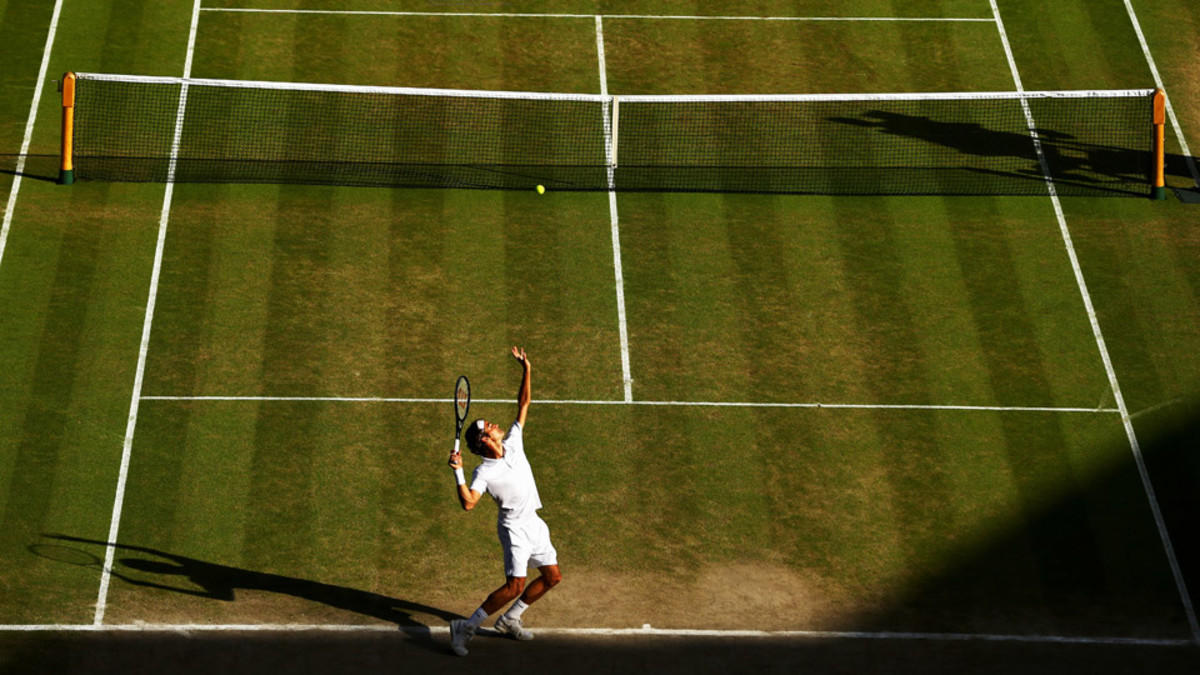
Inside the year-long process to prepare the Wimbledon grass courts
When play begins at the All England Club on Monday, June 29, some aspects of the tournament will be different than last year: the start time is one week later, two-time champion Rafael Nadal is seeded at his lowest-ever position at No. 10 and, less noticeably, Courts 14 and 15 are completely new in 2015. But don’t be ashamed if you can’t tell—the changes begin underneath the lawn, with drainage, stone layering and soil builds.
"Our job is then to get the top layer of soil on and seed,” says Wimbledon’s senior groundsman, Will Brierley, about the process, which is used to keep all 19 championship courts and 22 practice courts at the All England Club growing grass.
While rebuilding Courts 14 and 15 didn’t come without the challenges of “constant periods of wet weather”—a shocker, surely—using court coverings and the history of routinely redoing courts each year allowed the project to come through unscathed.
In fact, every court gets some sort of a rebuild each year. The process of getting the courts ready starts one week after the tournament ends with the championship court sward—a fancy term for an area of short grass—receiving a skimming of the top roughly 12 millimeters, a severe balding.
“This removes all weak and weed grasses from the sward and it reestablishes the levels where play has worn the surface,” Brierley says. Then crews till a seedbed to lay new seed—about one ton gets used each year—and fertilizer. Covering the courts with a semi-permeable translucent growth cover for up to a week regulates heat and moisture. A program of fall-time mowing helps firm the surface and levels the grass before each court receives a top-dressing of fine soil—about four tons total—and dragging to ensure perfect leveling.
The courts use 100% ryegrass and are made up of three cultivars to make for a dense sward with a better bounce. Each court’s “seedbed” gets rebuilt in the summer and fall above the sub-surface of drainage pebbles, drain pipes, small stones and coarse soil.
Prepping for the The Championships intensifies in spring. A post-winter roll removes frost and a spraying program starts in April to help with plant growth, durability, color and root development.
Novak Djokovic, Serena Williams earn top seeds for Wimbledon
“The date of this is worked back from the tournament start date to enable us to maximize the application of the chemical,” Brierley says.
Ever since March the sward at Wimbledon has come down about a millimeter every two weeks. Millimeter by millimeter, weather dependent, of course, the overall height of cut for The Championships slices from a hefty winter height of 13 millimeters down to a playing elevation of eight millimeters. That mark was hit almost four weeks ago, to let the ryegrass adjust to the stress before the tournament trampling begins.
During the tournament, daily care of the courts includes measuring wear and hardness. Groundsmen use The Sports Turf Research Institute to test soil moisture content, court hardness wear and plant chlorophyll levels to determine how much water each court will receive each evening.
“The tests will determine how much irrigation is needed at the end of play to keep the grass alive and keep the court firmness at a playable reading,” Brierley says.
Early every morning, Wimbledon courts receive a mow from a Toro cylinder mower and marks from a wheeled machine that lays titanium dioxide 50 millimeters wide for the lines—except the 100-millimeter baseline—requiring a total of about 500 gallons each year (practice courts get their care in the evening).
On the middle Sunday when no play occurs, the grounds crew uses a machine dubbed the Billy Goat to essentially vacuum and clear off any “kicked up debris from the first week’s play.” And unlike the clay courts at Roland Garros, the Wimbledon courts are not touched during play, except to protect from rain when needed.
Mailbag: Tennis' longevity trend, Roddick's broadcasting career, more
All championship and practice courts at Wimbledon receive the same care, ensuring that playing on Centre Court or practice court 9 give players the same experience “as close to humanly possible,” Brierley says. The only special need includes a machinery lift to help equipment get into No. 2 Court.
Brierley says that as planning continues for a new roof over Court 1, the work done prior to the roof on Centre Court with “regard to the conditions and changes that would occur after the roof was added to make sure that the roof would not be of detriment” was thankfully sufficient to keep that court’s sward on equal standing as all others.
“I believe that the upmost will be done in all the planning of the Court 1 roof to not create any problems for its future care,” he says.
And while major changes are afoot for Wimbledon’s future, Brierley says leading into the 2015 tournament was “rather quiet,” allowing him more time to do what he does best: care for the courts.
Tim Newcomb covers stadiums, design and gear for Sports Illustrated. Follow him on Twitter at @tdnewcomb.






